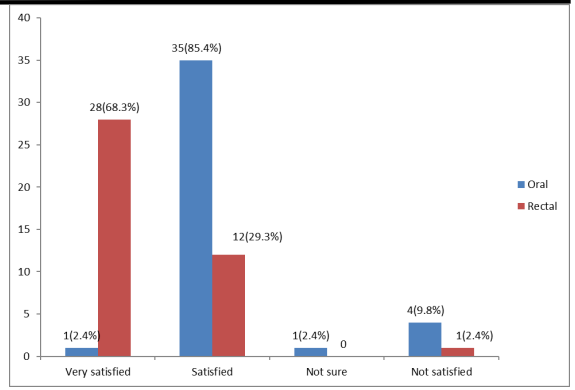Rectal Diclofenac Versus Oral Diclofenac in the Management of Pain after Episiotomy Repair: A Randomised Controlled Trial at LAUTECH (now UNIOSUN) Teaching Hospital, Osogbo, Osun State, Nigeria
Main Article Content
Abstract
Background
Safe and effective analgesia following episiotomy repair reduces postpartum morbidity. Oral diclofenac has proven to be of benefit in pain control, however, there is a need for an alternative route with the same analgesic efficacy because of the common significant side effects on the gastrointestinal tract. Hence, this study compared the effectiveness of rectal diclofenac to oral diclofenac in the management of pain after episiotomy repair at LAUTECH Teaching Hospital, Osogbo.
Methods
A randomised trial was carried out among parturients that had vaginal delivery and episiotomy repair from May to October 2020. 82 parturients (41 in each arm) were randomised to either 50mg oral or 50mg rectal diclofenac 12hourly for 24 hours after episiotomy repair. Pain score and level of maternal satisfaction were assessed, degree of side effects was also measured. Chi-square and Student t-test were used to identify association.
Results
There was no significant difference between the randomised groups in any socio-demographic characteristics. Rectal diclofenac group had a lower pain score (Rectal, Mean + SD 3.15+1.35 versus Oral, 6.46 + 2.85 p-value <0.0001), less need for additional analgesia (36.6% oral versus 7.3% of rectal, p-value =0.001) and improved level of maternal satisfaction compared to oral route (68.3% in rectal versus 2.4% in oral).
Conclusions
Irrespective of any socio-demographic characteristics, rectal diclofenac is more effective, has a high degree of acceptability and maternal satisfaction than oral diclofenac following episiotomy repair.
Downloads
Article Details

This work is licensed under a Creative Commons Attribution 4.0 International License.
This work is licensed under a Creative Commons Attribution 4.0 International (CC BY 4.0) license. To view a copy of this license, visit https://creativecommons.org/licenses/by/4.0/.
How to Cite
References
Justin RL. Episiotomy and Repair Technique. Cochrane Database Systemic Review. 2019;8:26-30
Trinh AT, Khambalia A, Ampt A, Morris JM, Robert CL. Episiotomy rate in Vietnamese-born women in Australia: support for a change in obstetric practice in Vietnam. Bull World Health Organisation.2018;91:350-6 DOI: https://doi.org/10.2471/BLT.12.114314
Annabel P. Management of Episiotomy: How to perform Episiotomy. Royal College of Midwives 2018;5:1-7
World Health Organization Reproductive Health Library: WHO recommendation on episiotomy Policy. Available from https://extranet.who.int/rhl/topics/preconception-pregnancy-childbirth-and-postpartum-care/care-during-childbirth/care-during-labour-2nd-stage/who-recommendation-episiotomy-policy (Accessed 17 February, 2019)
WHO recommendations for prevention and treatment of maternal peripartum infections. Geneva: World Health Organization; 2015 (pdf, accessed 17 January 2018)
Mathias A et al. Perineal pain management in the Immediate Postpartum period.2018;16(4):267-71 DOI: https://doi.org/10.5935/1806-0013.20150054
Medscape. Drugs and Disease: Diclofenac-dosing, indications, interactions, adverse effects and more. Available from medscape.com/drug/voltaren-xr-cataflam-diclofenac-343284 (Accessed 3rd March,2019)
Jodie MD, Hedyeh H, Elizabeth P, Neel H, Caroline AC. Rectal analgesia for the relief of perineal pain after child birth: a randomized control trial of diclofenac suppositories. British Journal of Obstetrics and Gynaecology. 2020;21:411-20
Shafi AF, Shazia S, Naheed B, Rizwana C. Rectal versus Oral analgesia for perineal pain relief after childbirth. Journal of Rawalpiridi Medical College (JRMC). 2019;15(1):56-8
Naz S, Naila YM, Asina S, Rafia B. Diclofenac rectal suppository: an effective modality for perineal pain. JMPA. 2018; 66:1005–8.
Seiqa S, Shakura B, Abida A, Arfat W. Effect of diclofenac rectal suppository on pain relief after mediolateral episiotomy – a placebo controlled trial. Asian Journal of Medical Research. 2019:6(2):1–5
Dodd JM, Hedarati H, Pearce E, Hotham N, Crowther CA. Rectal analgesia for the relief of perineal pain after childbirth: a randomized control trial of diclofenac suppositories. BJOG. 2018:11:59-64
Otakhoigbogie U, Osagbemiro BB, Egwim IC. A Comparison of Three Pain Assessment Scales in the Assessment of Pain among Dental Patients in Port Harcourt. European Journal of Medical and Health Sciences. 2020; 2(4):441 DOI: https://doi.org/10.24018/ejmed.2020.2.4.441
Sullivan L.MPH Modules: Power and Sample size determination.2019;20-21
Dasanayake DLW. A randomized control trial of rectal analgesia diclofenac sodium for relief of perineal pain following childbirth. SLCOG.2018:62:14-16.
The official website of the State Of Osun. Osunstate.gov.ng. Retrieved 26 August 2021.
Searles JA, Pring DW. Effective analgesia following perineal injury during childbirth: a Placebo controlled trial of prophylactic rectal diclofenac. International Journal of Obstetrics and Gynaecology. 2018; 105 (6):627-31 DOI: https://doi.org/10.1111/j.1471-0528.1998.tb10177.x
Shah S, Bhat S, Ahmad A, Waheed A. Effect of diclofenac rectal suppository on pain relief after medio-lateral episiotomy-a placebo controlled trial. Asian Journal of Medical Research. 2019; 6(2):1-5
Ojule J. Oriji V. Georgewell K.A. Study on perineal trauma in South-South Nigeria. Nigerian Journal of Medicine. 2020; 21(1); 1115-2613.
Mac Arthur A, Mac Arthur C. Incidence, severity, and determinants of perineal pain after vaginal delivery: a prospective cohort study. American Journal of Obstetrics and Gynaecology. 2018; 191: 1199 – 204. DOI: https://doi.org/10.1016/j.ajog.2004.02.064
Ghosh C, Mersier F, Consillat M, Benhamori D. Quality assurance program for the improvement of morbidity during the first three postpartum days following episiotomy and parineal trauma. Acute pain. 2018; 6: 1 – 7. DOI: https://doi.org/10.1016/j.acpain.2004.02.004
Norland Avenue pharmacy; a placebo controlled trial of prophylactic rectal diclofenac, effective analgesic following perineal injury during childbirth. Br. J. Obstet Gynaecol. 2020; 105(6); 627 – 31.





